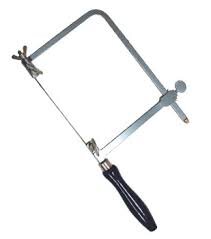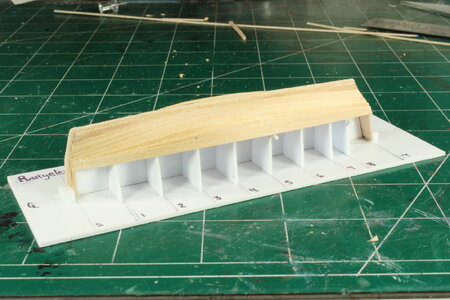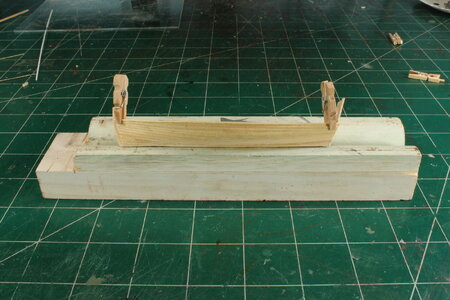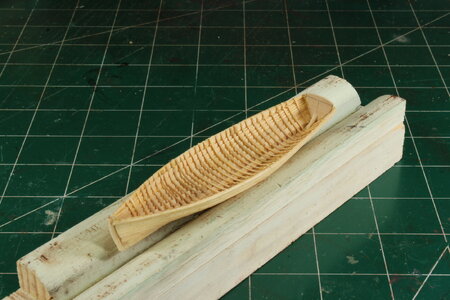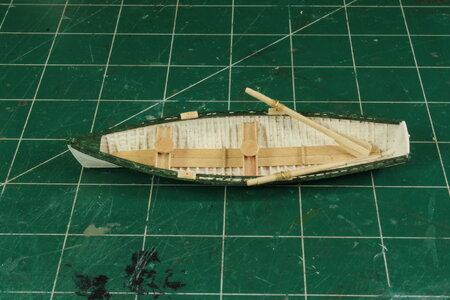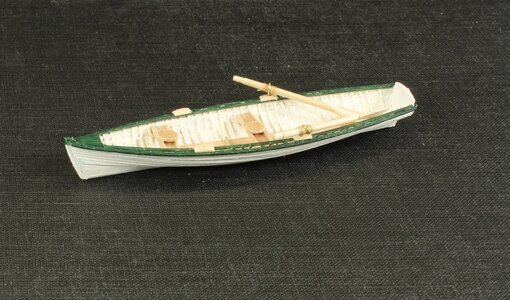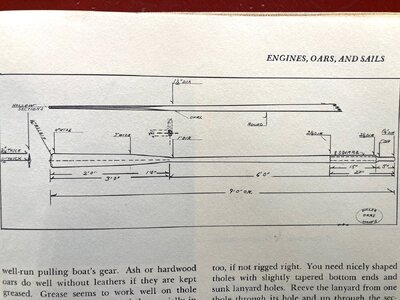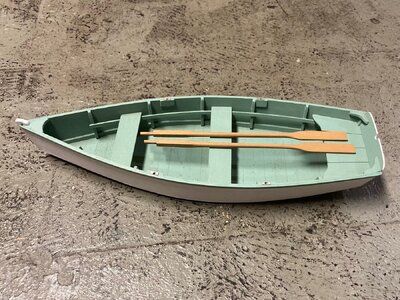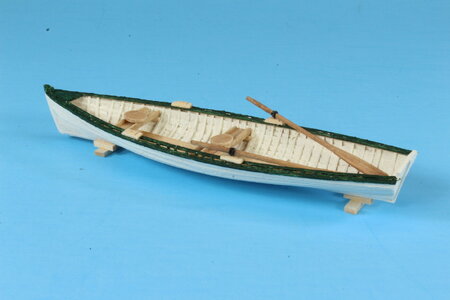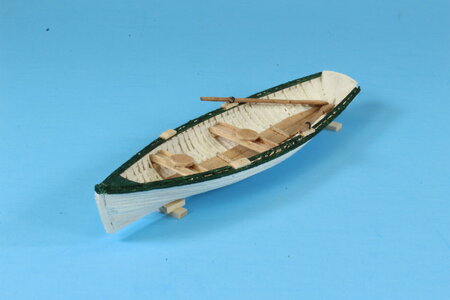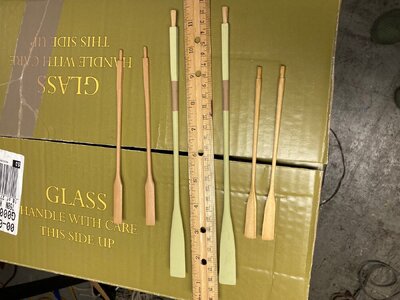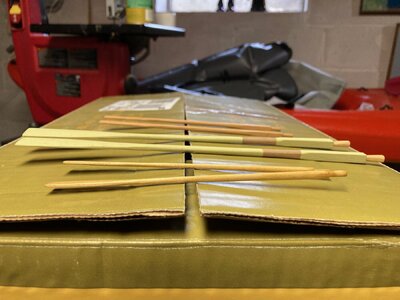I completed my Beachcomber Alpha Dory in 1/2" scale a few weeks ago. I decided my next build would be sort of model railroad related. I model a Maine 2-ft railroad in O scale (1/4"=1ft). I've shown a few photos on this site.
The Rangeley boat was developed for the fishing hobby in the Rangeley Lakes region of Maine starting in the late 1800s. Originally it was double-ended and looked more like a canoe. After WW1, they were adapted to use a small outboard motor by adding a transom on one end. That is the style I decided to build. When complete, I came use it on my model railroad or pass it along to a friend modeling the Sandy River and Rangeley Lakes Railroad.
I referred to John Gardner's book "Building Classic Small Craft" for the lines.
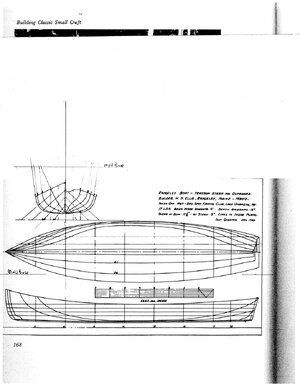
My plan was to scratch build the model using close-to-scale wood. Since these boats didn't have frames, I build a fixture/mold from sheet styrene. I glued a photocopy of the scaled drawing onto .060" styrene and laid out the location of the mold frames on another sheet.

I cut out the profile using a home-made "jeweler's" vise and a hobby coping saw. (I really need to get a powered scroll saw....)

To ensure the frames were exact copies of each other, I tacked 2 pieces of .040" styrene together, temporarily glued a copy of the from on top, and cut both out using the coping saw. Then I separated the 2 halves with a Xacto chisel.
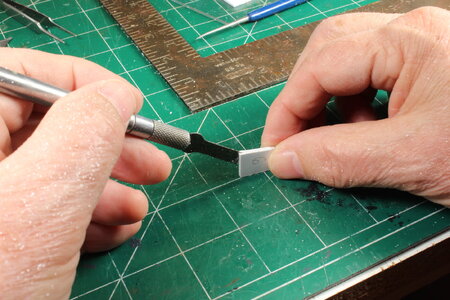
I then glued the profile along the base's centerline and then followed with the frames. Here I've tacked to a strip of 3/4" wood to make it easier to handle.

Then I constructed the backbone of the boat by forming the inner keel and gluing it to the inner stem and transom.
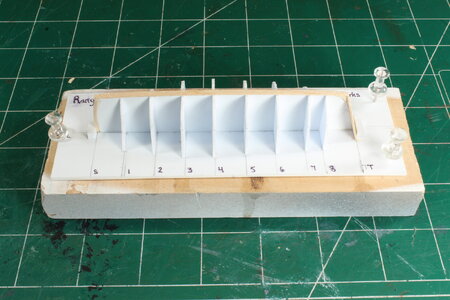
Next came the planking process. These boats were planked with lapstrakes so I needed thin-narrow strips of wood. Fortunately, I have a stash of model stripwood in various scales from my 40+ years of model railroading. Some packages are more than 40 years old! (It pays to never throw stuff out!) Most of it is HO, which works out to about 1/2 of O scale. So, a 1" think HO board is about 1/2" in O. Close enough for my purposes. Here I am about halfway through the planking process.

So far, I have spent about 20 hours over the last few weeks building this. I likely have about that much more to complete it.
Pete
The Rangeley boat was developed for the fishing hobby in the Rangeley Lakes region of Maine starting in the late 1800s. Originally it was double-ended and looked more like a canoe. After WW1, they were adapted to use a small outboard motor by adding a transom on one end. That is the style I decided to build. When complete, I came use it on my model railroad or pass it along to a friend modeling the Sandy River and Rangeley Lakes Railroad.
I referred to John Gardner's book "Building Classic Small Craft" for the lines.

My plan was to scratch build the model using close-to-scale wood. Since these boats didn't have frames, I build a fixture/mold from sheet styrene. I glued a photocopy of the scaled drawing onto .060" styrene and laid out the location of the mold frames on another sheet.

I cut out the profile using a home-made "jeweler's" vise and a hobby coping saw. (I really need to get a powered scroll saw....)

To ensure the frames were exact copies of each other, I tacked 2 pieces of .040" styrene together, temporarily glued a copy of the from on top, and cut both out using the coping saw. Then I separated the 2 halves with a Xacto chisel.

I then glued the profile along the base's centerline and then followed with the frames. Here I've tacked to a strip of 3/4" wood to make it easier to handle.

Then I constructed the backbone of the boat by forming the inner keel and gluing it to the inner stem and transom.

Next came the planking process. These boats were planked with lapstrakes so I needed thin-narrow strips of wood. Fortunately, I have a stash of model stripwood in various scales from my 40+ years of model railroading. Some packages are more than 40 years old! (It pays to never throw stuff out!) Most of it is HO, which works out to about 1/2 of O scale. So, a 1" think HO board is about 1/2" in O. Close enough for my purposes. Here I am about halfway through the planking process.

So far, I have spent about 20 hours over the last few weeks building this. I likely have about that much more to complete it.
Pete





